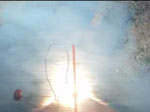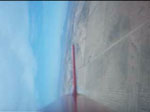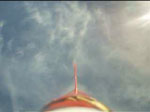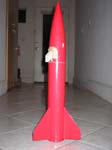



|

|

|
|
This is first my venture into Video Rocketry. Strangely
enough, it was not my initial goal to put a camcorder in a rocket. All I
wanted to do was add some weight to the nose of my
LOC Onyx. I had found that
there was significant enough weight change when using a G64 that the rocket
became unstable enough to be very susceptible to winds. I needed to add about
2 oz. to the tip of the nose cone, and was trying to figure out ways to do
that when I discovered the AipTek
Pocket DV2 or DVII.
It can record 320x240
video at 10fps onto a Compact Flash card (50-70 minutes on a 256MB card).
With 2 AA rechargeable batteries it weighs 184g and measures in at 3.3"
x 2.7" x 1.6", just right to bring the Onyx into stability when
mounted in the base of the nose cone. AipTek had a refurbished unit on their
site for $69.99, so I ordered it and proceeded to modify the LOC nose cone
for the Onyx. |

|
So I mounted the plywood cowl to the cardboard with medium gap filling CA glue and then mounted the cardboard onto the nose cone with nylon screws, I tapped the holes in the nose cone. I also put small strips of clear packing tape around the mounted cardboard so the wind wouldn’t go under the front of the cowl and rip it off Here it is, in it’s completed form and here are the first, and only so far, videos. Will open a new window: QuickTime Movie 4.5MB, DiVx AVI 320 x 240 3.5MB, and DiVx AVI 160 X 120 1.4MBActual files: QuickTime Movie 4.5MB, DiVx AVI 320 x 240 3.5MB, and DiVx AVI 160 X 120 1.4MB Launch site is Tucson, AZ, home of Southern Arizona Rocketry Association. Hope this was informative, and not too boring or long. glen_ba2000 on Yahoo VidRoc Group You can email me at glen_ba2000 at yahoo.com.
|